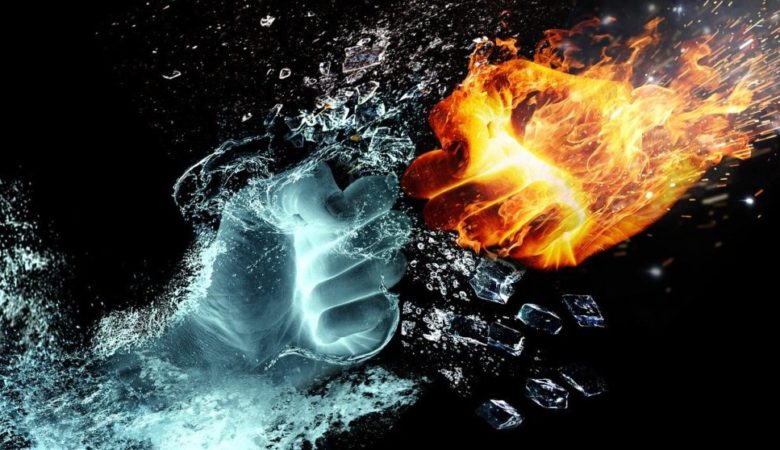Hot vs. Cold: How Contrast Therapy Shocks Your Body into Shape

Lying in an ice bath might not sound relaxing, but professional athletes do it for a reason. It’s true that icing your muscles reduces how sore you’ll be the day after a tough workout. Exposing yourself to extreme temperatures—both hot and cold—has proven benefits for building muscle and reducing stress. Contrast therapy can help anyone, regardless of whether you’re committed to a rigorous workout regimen or want to improve your health.
Many major fitness gyms offer contrast therapy, but you can easily do it from home. A hot bath followed by a cold shower is a mild form of contrast therapy that’s free and doesn’t take up a bunch of your time. While this method doesn’t achieve the extreme temperatures of a sauna or ice bath, regular contrast therapy in small doses is still good for your general well-being.
A closer look at contrast therapy
Contrast therapy exposes you to extremely hot and cold temperatures in short bursts. This often involves spending a few minutes in a sauna then immediately settling into an ice bath—or vice versa. The process hinges on rapidly heating your body, then rapidly cooling it with an extreme temperature swing. Rinse and repeat, over and over again. It’s a shock to the system to say the least! It’s important not to overdo it and spend too much time in either extreme.
Contrast therapy sounds extreme, and it is—but that doesn’t mean it’s only for the bravest of us or the those with a few loose screws! Professional athletes, endurance champions, bodybuilders, survivalists, health nuts and more all use contrast therapy in their training and recovery regimens. Why? Because contrast therapy does a lot more than just perk up your senses.
Improve training and performance
We spend most of our time indoors. It’s easy to take for granted luxuries that regulate building temperatures, such as air conditioners and thermostats. We’ve gotten so used to adjusting our living spaces to the most comfortable temperature and keeping it that way. However, this doesn’t do us any good when it comes time for that marathon in 100-degree heat or the brisk walk from the car to the office in subzero weather.
You can’t plan on the weather, which is why people use contrast therapy to prepare themselves for any scenario. Don’t let an exceptionally hot or cold day limit your performance. Don’t let your summer fun suffer due to heat exhaustion. Whether you play an outdoor sport or simply don’t want the temperature to ruin your vacation, contrast therapy will do you some good—even if it’s just a hot bath and cold shower back to back.
Benefits for the mind and body
Hot and cold exposures are essential for athletes performing strength workouts. Ice reduces delayed onset muscle soreness, and heat increases beta-endorphins and growth hormones. Beta-endorphins block pain while growth hormones rebuild muscle tissue that broke down during the workout session. Needless to say, contrast is optimal for recovery.
Contrast therapy isn’t all about muscle recovery, though. It can give you a better night’s sleep as well. Alternating between hot and cold temperatures resets your autonomic nervous system right before you go to bed. If you use contrast therapy for this purpose, just make sure the temperatures are milder than usual. Giving your body too much of a shock will wake you up instead of calming you down!
This form of therapy is as much mental as it is physical. The extreme temperatures develop the will power necessary to endure rigorous activity. Mental strength kicks in when we feel like throwing in the towel, so it’s important to exercise determination along with your body. If you can brave a hot sauna and a frigid ice bath, you can push yourself that extra mile to the finish line.
Finally, there’s an element of mood and mental health to account for. Cold water immersion (CWI) helps combat anxiety and depression. The frigid temperatures can more than double your levels of dopamine, a feel-good hormone your body naturally produces. CWI also increases norepinephrine—a chemical that energizes you—by over 500 percent!
The right way to do it
Contrast therapy is most effective if you do it at a certain point in your day. It’s recommended that athletes expose themselves to hot and cold temperatures a couple hours after working out. You could even reserve the therapy for one of your rest days. This is because exercise generates acute inflammation necessary for muscle repair. If you finish the workout session and immediately jump into an ice bath, this interrupts the recovery process.
Of course, contrast therapy requires listening to your body. Learn to recognize when you’ve had enough and it’s time to step out of the sauna. This form of therapy is great for building mental resiliency, but don’t go so far that it becomes dangerous. If you’re woozy, light-headed, or shivering uncontrollably, that’s your body’s way of telling you the treatment has gone on for too long.
No matter your lifestyle, contrast therapy offers benefits for everyone. You can adjust the temperatures however you like and can even do it from home. It takes only a few minutes and produces amazing results for your mind and body.

